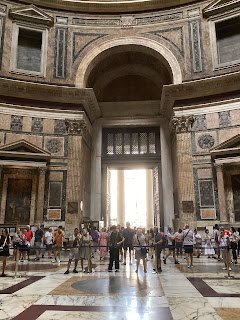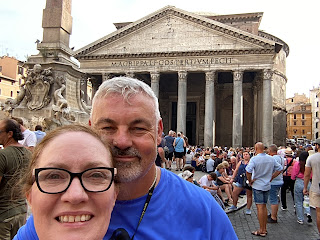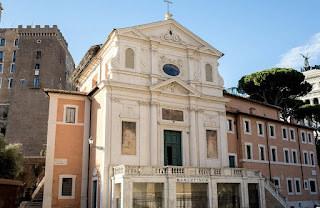Day 12
After the challenges of yesterday I woke up looking to reset and focus on the day ahead with as much positivity as I could muster. After a reasonable breakfast, we headed down the road a few blocks to meet our bus and headed into Rome to our first port of call, the Basilica of Saint Mary Major. In terms of church building hierarchy, this is one of the big guns and is the largest Catholic Marian church in Rome.
So who is Mary Major? The answer that immediately springs to mind is that she is the wife of ex-British Prime Minister Sir John Major. But this is incorrect for two reasons; Firstly, Sir John’s wife is called Norma and not Mary, and secondly, Dame Norma is about 81 years old and this Basilica has been around for at least 1,600 years. Our new guide Simon (pronounced Seee-moan), said that the Basilica is also referred to (sometimes), as Our Lady of the Snows, and as such, some have suggested that she might be the original Snow White. This of course is absolute rubbish. The Basilica is sometimes referred to as Our Lady of the Snows, because of a legend regarding a Roman patrician and his wife, a vision of the Virgin Mary and a sudden snow storm concentrated solely on a very precise Basilica-shaped section of a hill during the height of the Roman summer.
Mary Major is in fact the Blessed Virgin Mary, the Salus Populi Romani, (Protector of the Roman People), and we celebrated a lovely intimate Mass here this morning, which turned out to be the reset we all needed after the absolute shocker that was yesterday.
After Mass we did a tour of the Colosseum, the Roman Forum and the Pantheon, my absolute first, seventh and second favourite places respectively in the whole world. I could wax lyrical about all three for pages and pages, but instead I will restrict myself to just a few fun facts and some photos.
The Colosseum (or Colosseo), is an elliptical amphitheatre located in the centre of Rome, just east of the Roman Forum. It is the largest ancient amphitheatre ever built, and is still the largest standing amphitheatre in the world, (it could hold an estimated 50,000 to 80,000 spectators), despite its age. It was used for gladiatorial contests and public spectacles including animal hunts, executions, re-enactments of famous battles, dramas based on Roman mythology, and mock sea battles. Construction began during the reign of the emperor Vespasian in 72 AD, was completed during the reign of his successor Titus in 80 AD, with further modifications made during the reign of his successor Domitian. The three emperors were known as the Flavian dynasty, and the amphitheatre was named the “Flavian Amphitheatre” by later classicists and archeologists for its association with their family name (Flavius). Originally though, the building's name was simply “amphitheatre”. It is believed that the amphitheatre became known as the Colosseum because a giant bronze statue (based on the Colossus of Rhodes), depicting Nero as a solar deity, stood beside the amphitheatre during and after the reign of the emperor Hadrian. This statue was known as the Colossus and over time, the name transferred from statue to amphitheatre.
The Roman Forum (originally a marketplace), was the center of day-to-day life in Rome and has been called the most celebrated meeting place in the world. It was the site of triumphal processions, elections, and where statues and monuments stood commemorating the city's great men. It was also the venue for public speeches, criminal trials, and the nucleus of commercial affairs. Today it is a sprawling ruin of architectural fragments and intermittent archaeological excavations, and even though it wasn’t some of our pilgrims cup of tea, it still manages to attract 4.5 million or more people every year.
The Pantheon is a former Roman temple and, since 609 AD, a Catholic church (Basilicam Santa Maria ad Martyres or Basilica of St. Mary and the Martyrs). It was built on the site of an earlier temple commissioned by Marcus Agrippa during the reign of Augustus, then after that burnt down, the present building was ordered by the emperor Hadrian and probably dedicated around 126 AD. Its date of construction is uncertain, because Hadrian chose not to inscribe the new temple, but instead, retained the inscription of Agrippa's older temple (which is clearly visible above the entrance).
The Pantheon's large circular dome and conventional temple portico (a structure consisting of a roof supported by columns at regular intervals, typically attached as a porch to a building), was unique in Roman architecture. Nevertheless, it set the standard (becoming the exemplar for the classical look), and has been copied many times by later architects.
For lunch we found a little restaurant opposite the Forum and it was just bliss to have some rich Italian cuisine and people watch for a bit.
We then made our way passed “The Wedding Cake” (Victor Emmanuel II Monument), to the Mamertine Prison.
According to tradition, the Apostles St. Peter and St. Paul were both executed on the same day (June 29, 57 AD). St. Peter, not being a Roman citizen, was crucified and because he denied Jesus three times at his trial, asked for this to be done upside down. St. Paul, because he was a Roman citizen, was quickly and cleanly dispatched via beheading. The Mamertine Prison was the ancient empire's gaol for condemned criminals. It was here that St. Paul was incarcerated and is likely the place where St. Peter was held prior to his crucifixion, as well. The cell where they both would’ve been kept is still intact and lies deep in the bowels of the gaol. Dark, damp, claustrophobic, bug ridden, vermin infested and hot, is how I would describe the motel Maria and I stayed in one New Year’s Eve near Rouse Hill, and this place was almost as bad.
We spent hours walking with Simon from one end of town to the other and then back again in a blur of commentary, rocks, broken pillars, cobblestone, doorways, windows second from the left, chimneys that weren’t really chimneys, programs for upcoming plays at theatres, and, the spot where Julius Caesar got stabbed in the back by a bunch of so called mates (one of which was Popeye’s nemesis Brutus, so he should’ve seen that coming), before we hopped back on the bus weary and footsore, and headed for the magnificent Basilica of Saint Paul Outside The Walls.
According to tradition, after St. Paul was beheaded, his followers carried his head and his body to a place owned by a Christian woman named Lucina. There they buried him and erected a memorial, called a cella memoriae. About 250 years later, the first Christian Emperor Constantine I, erected a basilica on the memorial’s site.
Well played Constantine. This place is just spectacular! I have never been here before and it was just stunning.
St. Paul's tomb is located below a marble tombstone in the basilica's crypt below the altar. The tombstone bears the Latin inscription “PAULO APOSTOLO MART” which means, to Paul the apostle and martyr.
This was a really great way to finish the day.





































































No comments:
Post a Comment